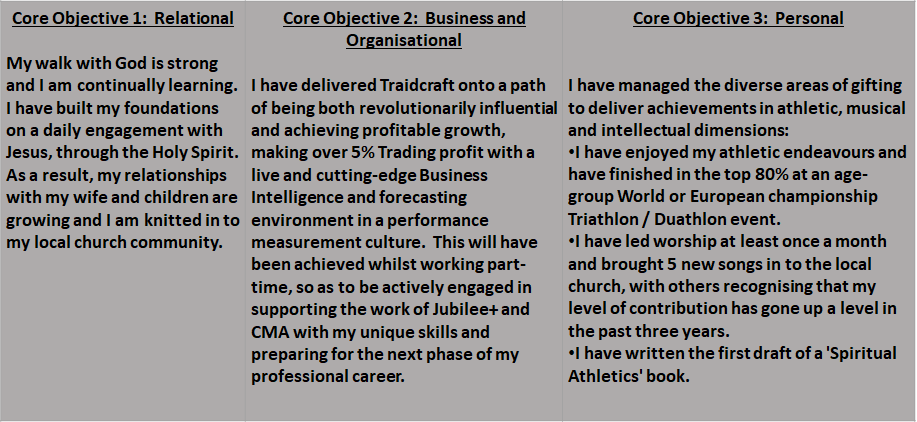Are three-year plans useful?
The surprising truth about the plan I created in March 2017…
In March 2017 I experienced a milestone in my professional life, which has led to me becoming more focused and productive that at any other point in my career.
As part of a peer-to-peer coaching group session, we had a visiting speaker, Pete Wilkinson, who led us through the process he had developed to create meaningful and deliverable plans.
I was, at that point, still in a salaried role at Traidcraft and I already had firmly decided that the three to five-year strategic plan cycles adopted by so many organisations were at best inflexible, and at worst just a complete waste of time.
Traditional business plans have a habit of consuming time and energy and then being put on the shelf and not embedded into the ongoing flow of activity. Therefore, my answer to the title question of “Are three-year plans useful?” would normally be “only if they are used on an ongoing basis”.
But Pete got my attention, not just because he chose a case-study close to my interests (training for an Ironman Triathlon), but because it was a fresh yet delightfully simple approach .
Pete’s approach, which he described as “1-3-5”, ties into the increasingly popular and successful OKR (Objectives and Key Results) framework. It has been shown to work because there is a constant quarterly rhythm of review, revision and application on the path to a longer-term goal.
My plan for what would be achieved by March 2020 ….
I’ll summarise the 1-3-5 method here and tell you what my plan looked like, but you can find more details of the method at How it works – Reclaro®
[And in case you were wondering - I’m not paid by or affiliated to Pete or Reclaro]
“1” - Define a single crystal-clear vision.
What you want to achieve and how much time you need to successfully achieve it . One stand-out part of the method for me was that Pete instructed us to write a succinct statement of our vision as if you’ve already achieved it – psychology to help us believe that the vision is achievable.
Since I know I was on an exit path from Traidcraft I chose to write a holistic plan about what I wanted to be/achieve in the next three-year phase of life. My target date was three years hence - March 2020. Far enough ahead for major progress to be made, yet not so far that I couldn’t feel the immediacy of the need for action.
My stated personal vision included achievement in all areas of my life – relationships, business and the things I do outside of work. Here’s what I wrote:
“3” Core objectives
The 1-3-5 method requires that we Identify 3 objectives that are absolutely core to the success of our “Vision”.
I divided my life goals into three areas, with specific outcomes defined. Whilst my professional career is important to me, I recognised the need to place relationships on an equal par. Additionally, since I spend a lot of time playing music and exercising, it was important to articulate how those areas were to contribute to the overall fulfilment of my potential as a human being.
Here are the three objectives I wrote:
“5” Quarterly goals
The achievement of goals only happens one step at a time, and so the final part of the 1-3-5 method is to set 5 actionable steps to help achieve each of my core objectives. They keep us moving forward and help to concentrate our efforts towards a successful vision.
The process requires that each quarter these goals are reflected upon, ticked off, rescheduled and re-planned, so that tangible progress is both made and celebrated.
I set my first quarter’s goals and embarked of on a path of building the habit of quarterly review…
So what happened?
Primarily, putting all my plans together into one statement helped me to reconcile the conflicting demands of the “work-life” balance. I realised that it is more important to be able to state “I am…” than to express a list of “I have done…” achievements.
And the process of quarterly reflection, reset of goals and celebration of achievements has transformed how I manage my quarterly and weekly work planning. Reflecting on my achievements was rewarding in itself and helped me to build the quarterly habit that I wanted to do each quarter.
Exactly how this works will have to wait for another blog, but regardless of what I did achieve, I attained a much higher level of strategic focus for my professional and personal affairs.
Did I deliver?
My honest self-approval must be that I did not achieve all the objective items I listed. But that is probably true for every business plan ever written, everywhere. When was the last time you finished your ‘to-do’ list?
But I did see significant progress towards that long term vision and am I happy with where I have got to!
There are many reasons why I may have fallen short, not the least of which are a serious bike accident in 2019 which put me out of action for months and then the global COVID pandemic, which is reason I’m writing this blog now, a year after the original plan end date.
Overall, I felt satisfied, because for four years now I’ve been able to have a reference point to lift my eyes to.
Where appropriate, be it on a daily, weekly or quarterly basis, I’ve been able to frame any decision about any use of my time against the question “How does this enable my “Vision” and “Objectives“ to be achieved?”
What does this tell us about corporate and personal strategic planning?
As Eisenhower once said – “Plans are useless, but planning is indispensable”
My March 2020 plan has not stayed as a static document. I left Traidcraft at the end of 2018 and reframed my professional vision and goals in terms of the InfoSuperstar and VISMAP businesses that I am currently involved with.
Each (usually annual) iteration has both continuity with the past sense of personal mission but has both adapted to circumstances and reframed loftier goals.
And so, it should be the same with our corporate planning. We all need a simple, easily communicated vision that articulates the purpose of the organisation.
Then we need a short (3 item?) list of objectives that the whole organisation is working to see achieved.
And only then, when this breaks down to the nuts and bolts of individuals of parts of an organisation, will each part have a micro-breakout of multiple, smaller-scale Objectives and Key Results that contribute to the overall Objectives. These then form the basis for planned activities and projects, which each have defined outcomes and cost/income budgets.
Only when that kind of ‘Tree of purpose’ exists, with twigs connected to branches connected to the trunk and the fundamental roots, is a plan ready to grow leaves and bear fruit.
What about you or your organisation?
There’s much more to say on purpose. You might want to make a note to look out for my next blog, where I shall be talking about what I learned from Simon Sinek’s “Start with Why” book.
For now, just ask yourself – “Do you have a simple clear vision statement written as if it is achieved?”
I’d be happy to have a direct chat with you, or even put you in touch with Pete Wilkinson. Why not check out https://reclaro.com/?
Until next time – adios amigos!
Andy Biggs
P.S. I didn’t want to divert from the flow of the above narrative by picking over exactly which parts of the 2017 plan I ticked off. However, I’d like to note that one of the highlights is finishing well above the 80% mark in multiple World and European Duathlon Championship events between 2017 and 2019. Here’s me doing so in Odense, Denmark in 2018.
INFOSUPERSTAR IS THE TRADING NAME OF REFLECT BUSINESS SOLUTIONS LTD, 47 WEARSIDE DRIVE, DURHAM, DH1 1LE UK | COMPANY REG No (ENGLAND AND WALES): 8672028














